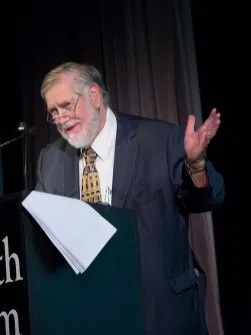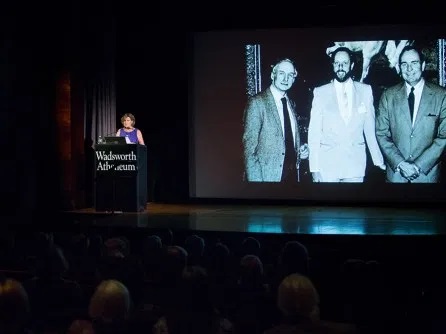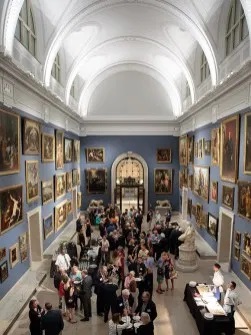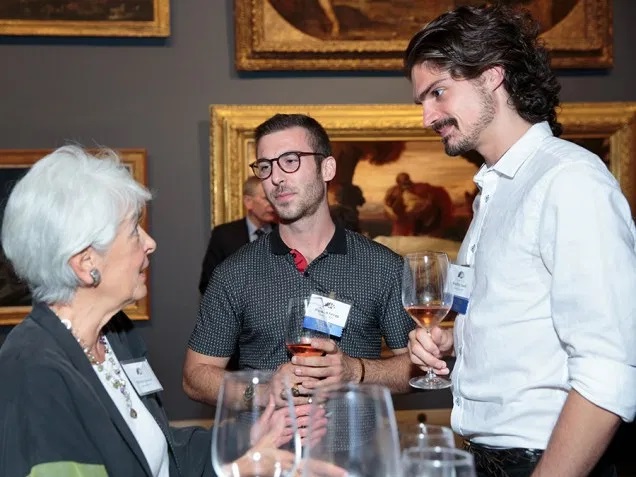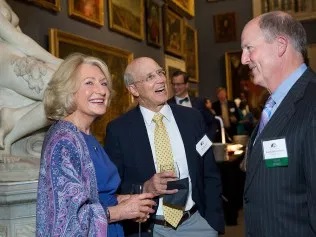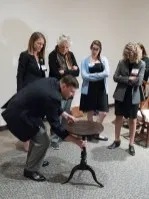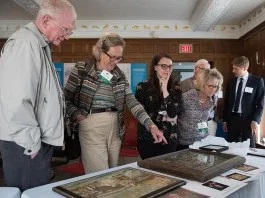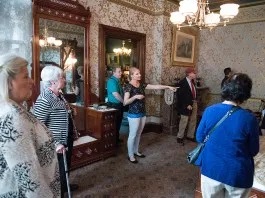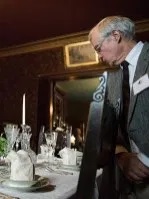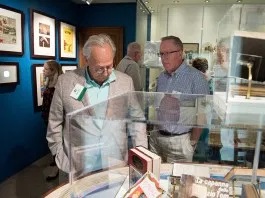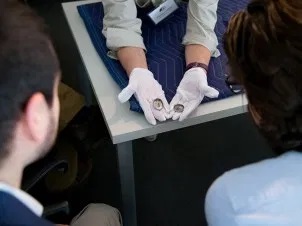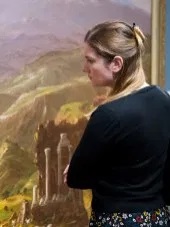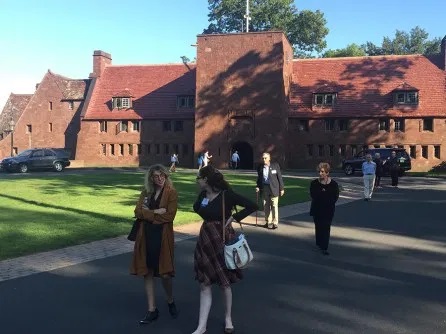CONNECTICUT: ALL MUSEUMS GREAT AND SMALL
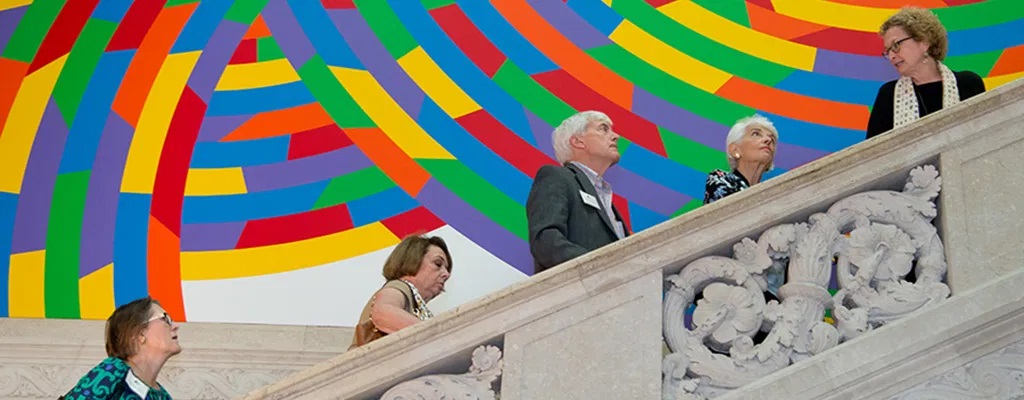
Hartford boasts impressive historic statistics: founded in 1635, it is one of the oldest cities in the country; the local Wadsworth Atheneum is the nation’s oldest public art museum; and the city is home to the nation’s oldest continuously published newspaper, the oldest publicly funded park, and the second-oldest secondary school. Compared to these, the Decorative Arts Trust is still a spring chicken at 40!
While our primary focus for the weekend was all things Connecticut, we took the opportunity to reflect on and celebrate this significant anniversary during our Thursday lectures and reception at the Wadsworth Atheneum. We were honored to have Jonathan Fairbanks and John and Penny Hunt emerge from well-deserved retirements to reflect on the past four decades of decorative arts scholarship and the growth of the Trust. As an organization, we have undergone tremendous transformation during our four decades while remaining true to our passion and mission of engagement with the decorative arts field. The Emerging Scholars Program has long been an essential component of the Trust’s mission and is a particular point of pride as a significant philanthropic force within the museum field. After the lectures, which brought back many fond memories and a few misty eyes, we adjourned to the recently reinstalled Morgan Great Hall for a celebration of this milestone.
Friday may have brought us back down to earth, but thankfully Connecticut is a wonderful place for a landing. We began the day at the Connecticut Historical Society, where a trio of lectures introduced participants to the craft traditions of the state. Speakers included renowned antique dealers Arthur Liverant and Kevin Tulimieri, former CHS curator Susan Schoelwer, and Kevin Ferrigno and Christina Keyser Vida, who have long maintained a scholarly interest in Connecticut furniture. Susan, Kevin, and Christina kindly led workshops on Connecticut needlework and furniture at the CHS during the afternoon.
Participants also visited two local icons, the Mark Twain House and the Harriet Beecher Stowe Center. These two literary icons of 19th-century America were friends and neighbors, and today the decorative arts take center stage to tell their story and celebrate their contributions. The fashionable furnishings throughout the Mark Twain House speak to the financial success brought about by the enormous popularity of his writings, while also interpreting his affectionate family life and gregarious entertaining of both local society and international celebrities in the house. By contrast, a humble dining table at the Stowe Center, likely made in Boston, takes pride of place as the surface on which Harriet Beecher Stowe wrote a great deal of Uncle Tom’s Cabin. The table is the focus of an entire gallery, where a short media presentation pays homage to the role of Stowe’s writing on the course of our nation’s history. The evening concluded with a special tour and reception at the Webb-Deane-Stevens Museum, an unusual institution that features three adjacent 18th-century houses. Although their owners, a merchant, a leatherworker, and a diplomat, were somewhat unlikely neighbors, the houses remain to interpret the rich history of the town of Wethersfield.
Saturday’s schedule introduced participants to museums and collections both great and small across Connecticut, which were superbly introduced by the morning’s lectures: Brandy Culp on new directions for the decorative arts at the Wadsworth, Jeannine Falino on the museum’s extraordinary Hammerslough Collection of silver, and Bill Hosley on the culture and craft of the Connecticut River Valley. All three lectures were a wonderful prelude to a series of tours of the Wadsworth’s extensive collection, which include everything from the Morgan Collection of European decorative arts to the homegrown Wallace Nutting collection of American furniture. Participants had the opportunity to glimpse behind-the-scenes areas at the Wadsworth rarely open to public access.
Because Connecticut offers something for everyone, participants could choose one of three options for the afternoon’s site visits. One group stayed local to Hartford, learning about the city’s 18th-and 19th-century history and architecture at the Butler-McCook and Isham-Terry Houses. Another group enjoyed an excursion to 20th-century sites, including the theatrical Chick Austin House, where Bauhaus design met Baroque furniture in a heady combination, before venturing to the Arts and Crafts style campus of Avon Old Farms School, designed by Theodate Pope Riddle, one of the first registered female architects in America. For those who still had not had their fill of antique furniture or sought an opportunity to make an acquisition, a third group enjoyed an excursion to Colchester for a workshop at the gallery of Nathan Liverant & Son, one of the premiere dealers in American antiques.
All good things must come to an end, but thanks to our Sunday lecturers ensured we ended on a high note. Two emerging scholars, Ben Colman and Willie Granston, presented their original research of the decorative arts of Connecticut, from locally made furniture to the legacy of building undertaken by Elizabeth Colt to memorialize her family. New discoveries of local history were highlighted by Catherine Fields, the director of the Litchfield Historical Society, whose presentation on Litchfield merchant Elijah Boardman’s ledgers delighted the audience. Our time in Hartford was closed by Bill Hosley, who gave a rousing introduction to the many small museums around Connecticut, each worthy of celebration and support.
The Trust’s 40-year milestone has brought our members to, by our count, 80 Symposia in 58 different locations. We have enjoyed a wonderful and memorable journey, characterized by deep friendships and a shared passion for the decorative arts. We are incredibly grateful for friends both old and new who made the journey to Hartford this September, and look forward to many exciting and adventurous years ahead!
About The Decorative Arts Trust Bulletin
Formerly known as the "blog,” the Bulletin features new research and scholarship, travelogues, book reviews, and museum and gallery exhibitions. The Bulletin complements The Magazine of the Decorative Arts Trust, our biannual members publication.








